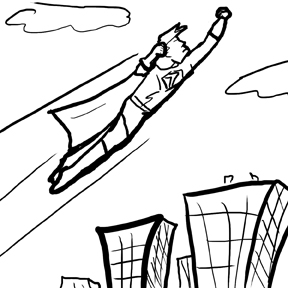For the past couple of columns (part one and part two), we’ve been examining "closure and synthesis" — the third of my "four criteria" for a new definition of what is a comic. Closure was defined as "the phenomenon of observing the parts but perceiving the whole" while synthesis is defined as "the process of the human mind to take the elements provided to them in a work and to create from them a new, but related element".
Closure and synthesis are both part of one of the four criteria because they are two sides of the same coin. They both speak to the fact that in comics, we are only presented pieces and fragments that we must assemble for ourselves in a coherent fashion. Comics, more than any other form of communication, rely on us being able to assemble different elements correctly in order to understand the message.
Synthesis speaks to the ability to take different elements in a given unit (such as a panel) and combine them into a coherent whole. Closure speaks to the ability to take that which we’ve synthesized and combine it with another element that we have synthesized. We assemble the artwork, letters, captions, balloons, and whatever else exists in an individual panel to create the idea of a moment in time. We then take that moment in time and combine it with the next moment to create the idea of a passage of time, an action, or even the lack of time or action. The neat thing about synthesis is that it is not constrained to a singular panel experience. Synthesis can occur outside of a panel, or even outside of the comic. Synthesis includes all the things the reader brings to the table. All of the emotional and intellectual thoughts the individual reader has or can have all help them synthesize. The more experience an individual has with reading comics, the easier it is to read comics. New readers often talk about being confused at first about how to put events in order, or what to read next. It is the personal experiences they have that help them put it all together. That’s what Synthesis is, taking what the creator has provided in panel and putting it together based on personal experience. Of course, the creator does assume that their audience all has some similar experiences. For example, if I was to show you a panel like this:

You, the reader have assembled what you see into a person eating something. Of course, it helps that the scene I depicted is an experience (I hope) you have regularly. Now, suppose I show a scene like this:

You should assemble it as a person flying through the air. Your personal experience helps you, because in our popular culture, even though people can’t fly, the image is something we’ve experienced. You synthesize what is happening immediately. However, if I were to show that image to someone who has never scene anything like it before, it may take them a bit more time to realize what it is. Even then, they may not totally accept the image. Their personal experience, being vastly different, changes how well they read the image. Their ability to synthesize is different than ours. That’s not to say they can’t do it, but it’s not a given to be taken for granted.
Closure and synthesis are vital to the definition of comics because comics will have images in them that can be singular, yet relate to a larger whole. It is only through closure and synthesis that the audience is able to piece things together. Without closure and synthesis, you will just have a bunch of images put together, some with text, some without, and no meaning will be made from the whole. It is only by realizing that the audience must participate, even at an unconscious level, that the creator can truly make a comic.
I had mentioned previously that the audience could even go so far as to synthesize new panels. Why would I say such a thing? Does that not inherently give the audience as much power, if not more, than the creator over the comic? I say thee nay! If the creator does their job right, the audience will likely synthesize only what is needed to complete the sequence.
I see the synthesis of new panels as akin to answering a question you’ve been asked. If I ask you what two plus two is, you are likely to answer four. In that sense comics have a lot in common with math in that we take things and add them together to create a new thing. As long as the creator is giving sufficient data to be able to expect a reasonable answer, then synthesis and closure will behave correctly. The real problem comes in when the creator has failed to give enough data and the audience is left to guess far too much. Even though closure and synthesis are processes that belong to the audience, the creator has a responsibility to make those processes as easy as possible.
I doubt that any attempt to really label the process the human brain goes through when reading a comic will ever truly be perfect. However, I do think that we need to acknowledge that something must happen in the mind of the audience, even if they don’t realize it’s happening! And without that something, the comic fails.
By acknowledging the importance of the audience, and understanding a little bit of what their unseen process is, the creator becomes just that more powerful. While the most base goals of any creator is clarity, giving thought to closure and synthesis will allow the creator manipulate their audience in a more meaningful way.
Animation Versus Comics
Comics are unique in that they are ultimately an exercise in the creator not showing the audience something. For example, if I create a film or animation, to show a man running down the street, I would show the actual movement — perhaps in fact each and every step. Or, I would include the sound of feet hitting the ground. Or, perhaps a blur of a background. There would be actual motion shown. In comics, however, there is no actual motion — it is all implied! Any concept of motion that was conveyed by the creator relied on the audience being able to finish that idea on their own. In comics, that audience takes a very active part in creating the finished comic, even if they don’t realize it. By synthesizing the movement of running, or by using closure to take the character in panel one and realizing that by panel two his location is different so he must have moved, the audience finishes the creation of the comic!
Sure, in animation, it is merely an illusion than someone is running, but the illusion is far more complete in animation than in comics. In animation, the burden of proof is on the animator to complete the illusion. If something is poorly animated, that is to say the motion is jerky, then the audience will often complain that it didn’t feel like the character was moving. In comics, we only imply motion. At no time do we try to fool anyone is saying something is actually moving. In comics, the burden is shared between the creator and the audience to complete illusion of motion. The difference between comics and animation is in animation, the animator says, “look, the person is running to the store” and hopes the audience believes him, whereas in comics, the creator says, “this is an image of a man running, a brief snapshot of what is happening” and hopes the audience will be able to get the person to their final destination shown in the next panel.
It should be noted that the creator realizes this, at some level. The creator knows that their image of a man running down the street is but one still frame after another. They know that when they put several panels next to each other, it completely changes everything. One panel of a man in mid-stride is an image of a man in mid-stride. Two or more panels of the same man in mid-stride with changes, such as the position of his legs or arms or the environment behind him, is a comic of a man running. When those two or more panels are viewed, synthesis and closure occur in the reader’s brain.
Next time, we will take a look at the last of the four criteria of my definition of comics: the use of Visual Language. What does that mean? Why is it important?
Comments are closed.